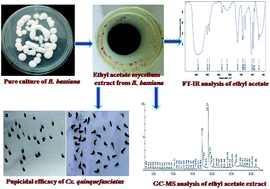Beauveria bassiana (Clavicipitaceae): a potent fungal agent for controlling mosquito vectors of Anopheles stephensi, Culex quinquefasciatus and Aedes aegypti (Diptera: Culicidae)
Abstract
Mosquitoes are the carriers of severe and well-known illnesses such as malaria, arboviral encephalitis, dengue, chikungunya and yellow fever, which cause significant morbidity and mortality in humans and domestic animals around the world. Entomopathogenic fungal metabolites act as a mosquito control agent and are potential alternatives to chemical control because they can be innovative and more selective than chemical insecticides. The main aim of the present study was to perform experiments on the larvicidal and pupicidal effects of the entomopathogenic fungus Beauveria bassiana (isolated from infected grasshopper) against the first to fourth instar larvae of Anopheles stephensi, Culex quinquefasciatus and Aedes aegypti. The larval and pupal mortality were observed after 24 h of exposure. The efficacy of an ethyl acetate mycelium extract at all the tested concentrations (50, 100, 150, 200, 250 and 300 μg mL−1) exhibited better activity against the 1st to 4th instar larvae of An. stephensi (LC50 = 42.82, 39.45, 25.72, and 32.66; LC90 = 254.67, 367.11, 182.27, and 199.20 μg mL−1), Cx. quinquefasciatus (LC50 = 72.38, 68.11, 27.06, and 35.495; LC90 = 481.68, 254.69, 129.83, and 146.24 μg mL−1) and Ae. aegypti (LC50 = 62.50, 52.89, 58.60, and 47.12; LC90 = 314.82, 236.18, 247.53, and 278.52 μg mL−1), respectively. The pupicidal activity of the fungal mycelium extracts was tested against An. stephensi, Cx. quinquefasciatus and Ae. Aegypti, where the ethyl acetate extracts had different LC50 values (LC50 = 40.66, 54.06, 44.26, and LC90 = 184.02, 225.61, and 263.02 μg mL−1). Based on Fourier transform infrared spectroscopy (FTIR) analysis and gas chromatography-mass spectrometry (GC-MS) analyses, the ethyl acetate mycelium extract contained six major chemical compounds identified as 9,12-octadecadienoic acid (ZZ)– (63.16%), n-hexadecanoic acid (21.28%), octadecanoic acid, phenyl methyl ester (10.45%), dehydroegosterol 3,5-dinitrobenzoate (1.86%), squalene (1.66%) and bis[3-(3,5-di-tert-butyl-4-hydroxyphenyl)prophyl]maleate (1.56%). The n-hexadecanoic acid standard was found to be better larvicidal against An. stephensi, Cx. quinquefasciatus, followed by Ae. aegypti. The HPLC analysis of the ethyl acetate mycelium extract was compared with that of the n-hexadecanoic acid standard and it was found to show a similar chromatographic peak (at a retention time of 3.383 and 3.378 min). The outcome of the present study identifies the bioactive compounds obtained from B. bassiana that can be used as effective and alternate larvicidal and pupicidal agents against the An. stephensi Cx. quinquefasciatus and Ae. aegypti mosquito vectors.



 Please wait while we load your content...
Please wait while we load your content...